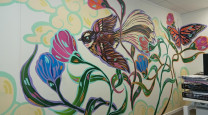
Amanda Harkness: Shaping the world of architecture and design at Architecture NZ
11 Sep 2023
Meet Amanda Harkness, the Deputy Editor of Architecture NZ, a dynamic figure at the forefront of architectural journalism in New Zealand. With a keen eye for design and a passion for the arts, Amanda plays a pivotal role in curating the magazine's content, collaborating with industry experts and spearheading initiatives like the Interior Awards. Her journey through the realms of media and advertising has led her to this remarkable position, where she celebrates the essence of architecture and design, consistently exploring the innovative and the inspiring. We spoke to Amanda about her role, journey and favourite projects, here is what she had to say:
Tell us about your role at Architecture NZ magazine?
As deputy editor, I’m involved with the planning of each issue alongside our editor, Chris Barton. We look to publish a good mix of projects and practices, from public, commercial, education and heritage to hospitality, residential and interior. Once we’ve agreed the content for a given issue, I work closely with a team of contributors, including writers and photographers, along with the architects and our art director André Kini, to pull everything together. As interior editor, a large part of my role involves convening the Interior Awards each year, which is a fantastic job, teaming up with a jury of industry specialists and reviewing amazing work from across the architecture and design industries. There are 10 categories to consider so it’s a big job but very rewarding.

Amanda Harkness alongside other judges for the Interior Awards. From left: Jon Rennie (Athfield Architects), Tessa Pawson (Peddlethorp), Scott Compton (Warren and Mahoney), Amber Ruckes (Waipapa Taumata Rau University of Auckland) and Amanda Harkness (Architecture NZ). Image by Toaki Okano.
What does a typical day look like for you?
I’m always conscious of the funnel of work – so any given day is about being across a large amount of material for the magazine and online (www.ArchitectureNow.co.nz) and keeping everything moving. I write the front of the magazine’s Across the Board section and Chris and I both edit the content that comes in from contributors. I also source all the imagery, which includes drawings, plans and photography. The best thing about my day is that there’s always something new and interesting to report on, be it projects, people, industry initiatives or awards. When the Interior Awards are in swing, I’m working with our publisher, Nathan Inkpen, on the programme, including choosing a jury and marketing and promoting the event. I then move into shortlisting, livestreamed judging, preparing finalist and winner coverage and, ultimately, fronting the awards event.
What has your career path been like to get you to this role?
It’s been very much focused on media and advertising. I’ve always been a keen writer so I did a BA in English Literature, with a couple of first-year architecture papers in the mix, and then moved into publishing (at ACP magazines, later to become Bauer), followed by advertising (Saatchi & Saatchi) and then TVNZ. When I had children, I became a freelance writer and PR. I was lucky enough to be writing for AGM (Urbis, Houses, Interior, Architecture NZ and ArchitectureNow) when the position of editor for Houses opened and I took on the role as deputy editor of Architecture NZ at the same time.

Amanda’s home she grew up in, a design and build that inspired her journey into architecture and design. Featured in Home & Building (1 Nov 1971).
What is it about architecture and design that interests you?
I’ve always loved architecture and art. I grew up in a house Dick Mercer (a contemporary of the Group Architects) designed for my parents in the Waikato. I’ve since found it in Home & Building (1 Nov 1971) and Modern Home & Garden (Summer 1970). It had slate flooring in the timber-lined entry, a cork-tiled galley kitchen separating the dining and family rooms, and a mosaic-tiled sunken bath with floor to ceiling glazing. It was fairly modest – four children in one bunk room – but beautiful. We moved many times before I went to university, both within New Zealand and to Fiji and France. I first discovered Le Corbusier in Paris, with the Foundation’s Villa La Roche and then his Villa Savoye in Poissy. I spent a lot of time at exhibitions at the Centre Pompidou, was there when Christo and Jeanne-Claude wrapped the Pont Neuf and saw the Pei Pyramid under construction. Nearby, UK and the rest of Europe were full of incredible projects – both modern and classical – the Tate Modern was always a favourite, as was the Conran Shop in the restored Michelin House.
Do you have a favourite project you’ve seen featuring Resene?
In every issue of the magazine is a ‘project’, more specifically an artwork, created by an architect or designer. It’s called the Resene Colour Collab and it’s a collaboration between the person we’re featuring and creative Thomas Cannings. Every collab is so different and evocative. I interview the featured person to see how it came about – the thinking behind it, the references, the memories. It’s fascinating and revealing at once.
I also love Pac Studio’s Point Wells Cricket Club (2020), a tiny project but full of personality. Its exterior is Resene Pioneer Red top-to-toe, much like the colour of the cricket ball, and inside, in complete contrast, is the fresh, vibrant blue of Resene Coast.

One of Amanda’s favourite projects, Point Wells Cricket Club. The exterior is painted in Resene Pioneer Red and interior in Resene Coast. Image by David St George.
Do you have a favourite Resene colour?
I have a very recent one. After the January floods, we had to strip and rebuild a downstairs living space, which had been ankle-deep in water. The room had been painted in Resene Mako (a blue-influenced grey) and I was keen to try a deep, sage green. After what seemed like 63 testpots, we discovered Resene Kelp, which I love. It’s an earthy, wood-bark green. We painted the ceiling as well and it’s such a warm, comfortable space now. I’m very happy with that discovery.

Published: 11 Sep 2023






